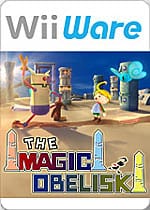Throughout the years puzzle games have been known to come in all shapes and sizes. In one you may be tasked with fitting different shape blocks together in order to make completed lines disappear, and in another you might be spinning colored spheres into various formations. More often than not, though, these games are completely focused on the act of completing puzzles and have no story or other motivations to speak of other than just finishing more puzzles in order to move on to the next ones. The Magic Obelisk, on the other hand, attempts to deliver both a touching and thoughtful story as well as some deviously clever puzzles to overcome, and, for the most part, largely succeeds on both accounts.
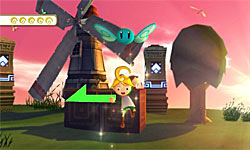
The story in The Magic Obelisk is a simple one that tends to skew towards a younger audience, but it has a good message and is conveyed rather well through conversations with other characters and cutscenes. It follows Lukus, an eager tree spirit looking to help as many people as he can on his quest to eventually find the perfect place to settle down and take root. Tree spirits look like young children but upon stepping into the sunlight will transform into a tree, providing shade and protection from the elements to anyone in need thereafter.
While this may sound like a standard video game story, there are a couple things that occur during the course of the game story-wise that I didn’t expect out of a five dollar downloadable title aimed at a younger audience that really impressed me. If you want to avoid any spoilers involving this game’s story, skip the rest of this paragraph and the next one now. [**Begin spoiler alert**]With all of the good that Lukus is doing for others throughout his journey while in his humanoid form, he begins to question whether or not he should turn into a tree. The reasoning behind this is that he’d then have to stop directly helping these other people who are seemingly in constant need.
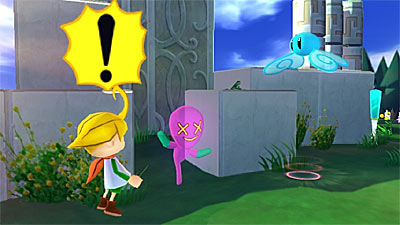
At another point in the game Lukus also comes into contact with one particular robot, robots being a recurring enemy type in this game, that is planting seeds and making a garden. A few levels after this it is discovered you are helping a bear to find a birthday present for his mother and you decide to raid this robot’s garden so that he can give his mother a bouquet of flowers. Instead of the game simply moving you along to the next level, the camera sticks around a little longer and actually shows the robot discovering his recently decimated garden. At this point viewing the reaction of the heartbroken robot actually made me feel somewhat bad about what I’d done and gave me a feeling of sympathy for what is otherwise just supposed to be one of the enemies in the game. {**End spoiler alert**] While it may not impress everyone as much as it did me, it is still hard to believe that a five dollar downloadable title aimed at younger players would even be attempting to tackle deeper, thought-provoking issues such as these, but it is a very welcome surprise.
Much like the game’s story, the gameplay itself in The Magic Obelisk is also pretty well done. Every level in the game involves getting Lukus from where he starts off to either a goal point or to whatever item he is currently looking for in order to complete it. Since Lukus is also in search of the perfect place to take root, he doesn’t want to step into the sunlight until he is ready to become a tree. This is why the entire crux of the puzzles in the game is you trying to connect the shadows and shade provided by objects so that Lukus can proceed on his journey in the safety of darkness.
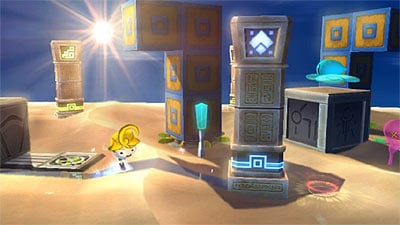
While the main character of the game is Lukus, you’re actually playing as Popo, a winged light spirit whose job it is to provide the shaded paths for Lukus. You will accomplish this by flying to various obelisks scattered throughout levels and shining light at them in such a way that you cast shadows that can be used to connect the already present shaded parts of the screen. Although this may sound pretty simplistic, and admittedly it is in the early stages of the game, by journey’s end there have been so many layers added to this concept and timing has become so crucial that it can often be very difficult to both see the solution you need and complete it within your allotted five mistake allowance for each level.
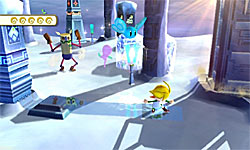
You’ll find three different kinds of obelisks in the game, each with their own unique properties. The most common are red obelisks, which provide heated shadows that can be used to make saplings instantly grow into trees and burn robot enemies, making them dash hysterically in whichever direction they are facing. Yellow obelisks harness the power of wind, allowing Lukus to be swept upward in these paths which can be used to cross over large chasms and water that would otherwise be impassible. Blue obelisks are perhaps the trickiest to use in the game, making ice shadows that Lukus will uncontrollably slide across at great speeds. These require some patience and precision to use because if Lukus isn’t in the exact position he needs to be in, he’ll wind up sliding directly into the sunlight. Blue obelisks can also be used to freeze robot enemies, providing a temporary amount of shade behind them or even a brief immobile weight on an unreachable switch. Mixing these different abilities together keeps the game’s puzzles feeling rather fresh and makes you really think about exactly how you are going to make it from one shadow to the next.
Presentation-wise, The Magic Obelisk is also quite good. The characters, environments, and music all mix together nicely into what ultimately feels like a children’s story book come to life. Lukus himself even has a few facial expressions to help him emote; although I do feel that he seems a little too similar to Link from The Legend of Zelda: The Wind Waker in terms of design and his reactions. Still, The Magic Obelisk was a thoroughly enjoyable title from beginning to end. With over thirty levels, an interesting story, and a unique style of puzzle gameplay, I would honestly have a very difficult time coming up with a better way to spend five dollars.
RATING OUT OF 5 RATING DESCRIPTION 4.0 Graphics
The characters and levels look quite good and the cinematics are nice, too. 3.7 Control
For the most part it handles nicely, although, you will sometimes run into issues when trying to direct shadows and Lukus himself. Fortunately, they aren’t deal breaking. 3.9 Music / Sound FX / Voice Acting
The sound effects can get repetitious but the soundtrack is great. 4.0
Play Value
For five dollars and having over thirty levels, you’re getting a ton of game for your money. Plus, it’s fun to play from start to finish.
3.9 Overall Rating – Good
Not an average. See Rating legend above for a final score breakdown.
Game Features:
